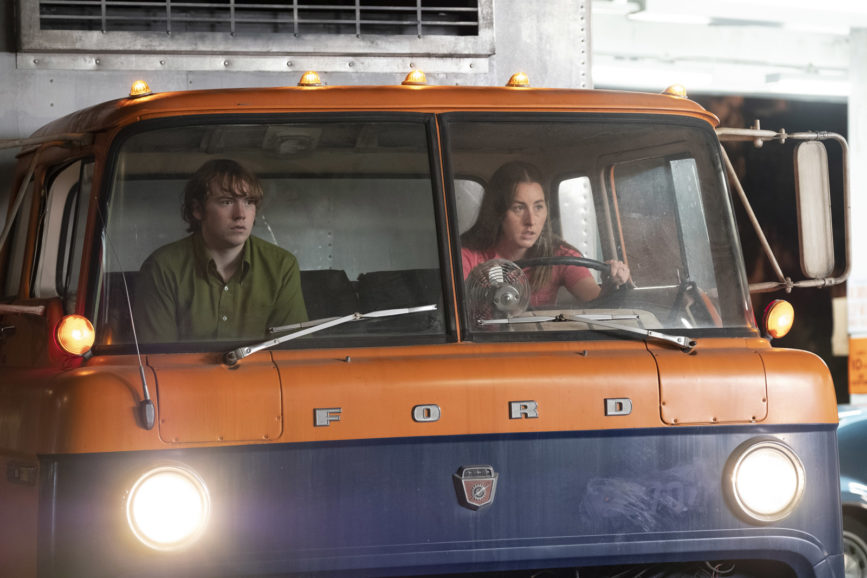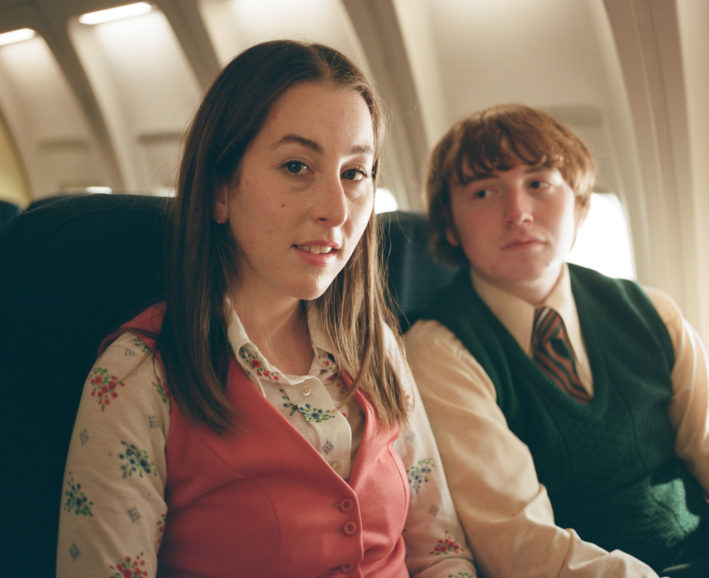MAKING MOVES
Michael Bauman makes the transition to director of photography on Licorice Pizza, the latest film from director Paul Thomas Anderson.
Historic gaffer Michael Bauman has had his hands in a lot of pies this last year, perhaps most notably on the Oscar- and BAFTA-nominated Licorice Pizza. “Second of three”, as he refers to back-to-back-to-back projects, Licorice Pizza follows an immaculate lighting design on The Tragedy of Macbeth for Bruno Delbonnel ASC AFC, with director Joel Coen, which helped to gain the former an Oscar and BAFTA nomination for cinematography.
It also predates an upcoming, as-of-yet untitled release with cinematographer Emmanuel Lubezki ASC AMC, and David O. Russell, that will star Christian Bale, Michael B. Jordan, and Margot Robbie.

Over the last quarter of a century, he has spent in filmmaking, Bauman, who studied at the American Film Institute, has associated with a rogue’s gallery of the very best in the industry. Having gaffed for two of Paul Thomas Anderson’s previous cinematographers, Mihai Mălaimare Jr., and Robert Elswit ASC, on The Master and Inherent Vice, respectively, it’s a “super collaborative” relationship with Anderson that culminated in his second feature behind the camera for the auteur, though his fourth film with the director.
“It’s a constant back and forth about the technology, it’s fun, it’s a banter!” he laughs. “It is absolutely a thousand percent his vision, but it’s not like my way or the highway. We have a dialogue; we have our own opinions. And there are interesting things happening because of that environment he has created.”
Bauman and Anderson share co-credit as director of photography for Licorice Pizza, while he was given the honourific, “lighting cameraman”, on their previous full-length endeavour, Phantom Thread. This was homage to the same credit received by John Alcott BSC on Stanley Kubrick’s Barry Lyndon, referenced for that film as it was a period piece modelled largely on the effects of available light.

This time around, as Licorice Pizza is set in 1973, they looked at classics from the ‘70s, like Fast Times at Ridgemont High and, especially, American Graffiti. Haskell Wexler ASC a “visual consultant” on American Graffiti to freshman director George Lucas, was a big influence on Bauman as to how he approached a few key exterior scenes that were shot at night.
“What is cool about that is that nobody really screens print anymore,” Bauman says. “All these studios are sitting on thousands of prints!” Anderson merely has to pick up the phone to talk with some of his many friends at the studios to get pretty much any movie that they wanted.
The pair first met in 2013 on extensive lens tests that Bauman put together for Anderson on a Fiona Apple video, Hot Knife. After, they smoothed out their workflows on music videos for Haim and Radiohead.

“He really enjoys the analogue process,” says Bauman, chuckling outright that “digital isn’t even a consideration” when asked if they had looked at that capture platform over film. Anderson is such a film acolyte that Deluxe gave him their 35mm and 70mm projectors when they closed down the Hollywood brick-and-mortar facilities in 2014.
Anderson always does a lot of lens testing, no matter the project, and Bauman says that many on their team will expect a short eight-hour day only to lament full cartloads of lenses as they are brought in, one-by-one, for comparisons. Anderson keeps a library of his lens tests from over the years, which helped to streamline the focal and lighting choices that they made quite a bit.
Nominated for Best Film, Best Direction, and Best Original Screenplay by both BAFTA and The Academy, Licorice Pizza was originally scheduled for 58 days, and ended up shooting for roughly 65. A love letter to the golden era of movie and television broadcast as much as it is to young romance and to the San Fernando Valley, Anderson’s sprawling hometown just north of Los Angeles, it’s named after a former SoCal record store chain.

There are a number of ‘70s-centric sets that were headed by production designer Florencia Martin, such as a “newly legal” pinball arcade (dastardly!), a store that sells only waterbeds, quickly “tanked”, so to speak, by the gas crisis of ’73, and the lush, shag-a-delic carpeting of the house of infamous ‘70s film producer Jon Peters. Peters’ house was actually shot at a Tudor manor previously owned by Wonder Woman-series actor Lyle Waggoner.
Bauman says that a lot of the production workflow involved location scouting ahead of time with Anderson and Martin. He took around 12,000 still photos to annotate things like exposure, continuity, colour, and location. To achieve “classic anamorphic blue flaring”, explains Bauman, they chose the Panavision C Series as their primary lens set, which dates back to 1968. The Panavision headquarters in Woodland Hills is also close to the director’s house, which has its own theatre for testing and chart needs.
Through Dan Sasaki at Panavision, an integral, often silent participant in Anderson’s movies, they were able to find a lens set that had been used by Gordon Willis ASC, fortuitous as the two used one of his films with Woody Allen, Manhattan, as resource material.

“There’s this quote that Gordon Willis has,” remarks Bauman about the famous silhouette scene of Allen and Diane Keaton beneath the Queensboro Bridge. “Woody Allen, apparently, in dailies, was like ‘Gordon, I can’t see them!’ He says, ‘No, but you can hear them!’”
In addition to the C Series, Anderson owns his own rather rare focal lengths, accumulated over the years. Bauman refers to a favoured, antiquated Pathé 50mm lens hilariously as “that damn thing”, explaining that he could often expect it to come out during any low light situations.
Captured on the Panavision Millennium XL2 35mm camera with Kodak 5219, 500T, and 250D stocks, they blew up from the 35mm prints to 70mm for limited runs in Los Angeles, New York, and a few other major cities. Film finishing, digital dailies and lab services were provided via Fotokem.

Bauman and Anderson pushed film development roughly a stop throughout Phantom Thread to diffuse contrast. With Licorice Pizza, they were more selective, only pushing exposure for a few scenes as necessitated by lighting conditions. He exposed at box ratings for the most part, sometimes overexposing by a third of a stop, which eventually became their workhorse process for any interiors.
On Phantom Thread, they had mixed a lot of atmospheric smoke with low contrast optical filters to create depth and fill. “There wasn’t a lot of that kind of filtration on this job,” he continues. “It was more about seeing how much you could lean into the lens.”
The Van Nuys Golf Course became a major location shoot not once, but twice. The Billingsley, a restaurant on the greens, was substituted for interiors that were designed to match the classic ‘70s aesthetic of the Tail o’ the Cock, a restaurant in the valley known for its many celebrity regulars.

Outside the Billingsley, the golf course became a backdrop for a chase scene of sorts, as “Jack Holden”, a caricature of actor William Holden, most famous for Billy Wilder’s Sunset Boulevard, played by Sean Penn, is inspired by actor and singer Tom Waits to a drunken motorcycle jump. This scene was one of the setups where Wexler’s work on American Graffiti came in handy, as both pictures were fairly restricted when it came to lighting concerns.
“Normally, you put a couple lifts up, glass, add some light in there, and that just wasn’t an option,” he says. Barely south of the Van Nuys airport, planes were landing and taking off, so the production wasn’t allowed to use anything higher than 30-feet.
“I was like, ‘We’ve got huge night exteriors here man! How do we build practicals into this whole thing?’ So, we laid out tonnes of smoke, low-level smoke, and then lit the smoke to get separation… and we were shooting into a bunch of 5Ks two blocks away, just so there’s something going on in the background.”
For interiors at The Billingsley, aka the Tail o’ the Cock, key lighting was provided by a unique array of warm lights that simulated the warm incandescence of the ‘70s. Calling them the Bling Lights, the nomenclature comes from his work with Harris Savides ASC on Sofia Coppola’s The Bling Ring, Savides’ final film before he passed.

“Chris Menges BSC had this thing where he would make these boxes, basically take light strip sockets, and screw in 15-watt bulbs, and jam them into this box,” says Bauman. “You have all these bulbs going, really warm, like 2000 degrees Kelvin, but very soft. We formalised it a bit with Harris, and we called them the ‘Bling Lights’, and then we just kept making that better and better. And so, for a lot of the interiors, Paul really liked the Blings. Low wattage, large quantity, packed together, bulb-to-bulb, a very soft, warm source.”
Co-founder of LiteGear, which manufactures specialised LED solutions, as well as Lux Lighting, a full-service rental house, Bauman is certainly no stranger to LED technology. “We were able to still use a tonne of LED,” he adds, “because it was all that we could do in some of these locations, but always playing on the warmer end of the colour spectrum.”
He says that he also found a lot of challenges on Licorice Pizza, however, and laughs that Anderson would rib him frequently during the production about using “real lights” over LED. He wanted to work with carbon-arc lights for Licorice Pizza, for instance, requiring quite a lot of power as well as a lot of management.

“You need to have basically one person for each head,” Bauman says. “I’m like, ‘Oh my God, this is how they used to do it! Hundreds of thousands of movies and they’ve been doing carbon arcs. I would remember hearing a lot of the old-school crew guys talking about huge arc-rigs, like 80 of them, 100 of them and I’m like, ‘We’re having trouble dealing with three.’”
Bauman thanks Justin Dixon, who stepped into his shoes as gaffer, and “did an insane job”, as well as key grip Jeffrey Sherman Kunkel, camera op Colin Anderson, and 1st AC Erik L. Brown, whom he considers a “lens savant”. Brown was instrumental in tweaking the C Series lenses to the specific needs of the production with Sasaki at Panavision.










